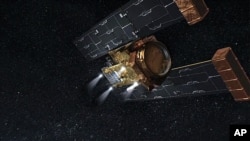A well-traveled comet-hunting spacecraft is headed into retirement.
The U.S. space agency says the unmanned spacecraft Stardust will burn off all its remaining fuel in a single burst Thursday at 2300 UTC, and then its transmitter will be shut off and the spacecraft left to drift.
Project manager Tim Larson says the final engine burn serves a purpose beyond emptying the tank. He says it will provide information to NASA engineers about how much fuel was left in the tank. NASA says this will help them make more accurate predictions for future missions - crucial because they say no one has invented a reliable fuel gauge for spacecraft.
NASA predicts the final fuel burn will last around two to 10 minutes, although it will continue firing the engines for 45 minutes. Stadust will transmit information about its fuel usage as the burn happens.
Since it was first launched in February 1999, Stardust has traveled more than 5.5 billion kilometers. It has flown past an asteroid and two comets, and has returned comet particles to Earth in a sample capsule.
NASA Retires Comet-Hunter Stardust
